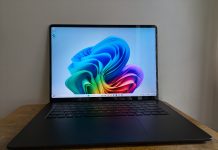In the 14 odd years of writing things for Ausdroid, the most challenging reviews by far have been laptops, and it’s become worse over time. It’s not for lack of interesting hardware, a lack of innovation in the space, or any other malarkey… it’s more because laptops have become variations on a theme and there are vastly more ways that they are the same than the few differences which set them apart.
In this regard, it goes without saying I had some difficulty reviewing the Dell XPS 14 9440 (herein, just the XPS 14) because so much of the experience is the exact same thing you can get on any other capable laptop. Much of what you experience on a laptop has less to do the with the CPU, the speed of the RAM, the size of the SSD or the bells and whistles within, and so much more with the fairly homogenous experience of Microsoft’s Windows 10, or nowadays, Windows 11.
Of course, laptops vary wildly; there are cheap and cheerful laptops that are in the order of a couple of hundred dollars, and there are those which can range up to thousands (if not many thousands) of dollars — at $2500-ish, the Dell XPS 14 sits somewhere in the middle; it’s undoubtedly a premium device with a nice, simple aluminium and glass construction, but it’s not so expensive that it’s unobtanium for most.
There’s a whole lot of marketing guff, but the crux of the matter is this – the Dell XPS14 can have up to a 14.5″ 3.2K OLED display, an Intel Core Ultra 7 processor, NVIDIA GeForce RTX Laptop GPU with 6GB VRAM, and SSD storage of course, with your choice of Windows 11 Home or Pro.
You might think that much of this is the middle of the road when it comes to laptops in the $2,000 range and – mostly – it is. What sets the Dell XPS 14 apart from others, though, is not its internals – its a laptop and does laptop things – but for me its the construction.

This is a solid, well constructed laptop that doesn’t creak as you use it, that doesn’t scuff or damage easily going into bags or across desks, and looks the part. In an era where most laptops are black or grey things, a nice light aluminium finish looks different, and the construction of the keyboard, trackpad and hand rests matches. It’s enjoyable to use.
Running Windows 11, and being relatively new, the XPS 14 also comes with Windows 11 Copilot, which is an AI powered tool built right into the OS. You can ask it questions, seek inspiration and get solutions to problems. The brochure says that Copilot can do nifty things in a conversational style, retaining context so you can ask for clarification, more information, or a change in direction. It can produce code, tell you about history and more… but despite the hubbub in the marketing material about on-board AI performance, Copilot is not an on-device experience; it requires an internet connection as the AI chops come from Microsoft’s cloud services.
Rather, the on-board AI credentials via the NPU are useful for different things. Dell tells us that it can do fancy things with Microsoft Teams through the use of Windows Studio Effects (and, yes it can). It can also enhance the experience of editing media eg. through Adobe Lightroom. You can also leverage it to run large language models locally, if that’s your wish, but few end users will really want or need to do this.
Ultimately, it’s a bit of a sideshow, and it takes away from the XPS 14’s main selling points – a powerful laptop, well made, at a competitive pricepoint with some incredibly powerful internals for those who want the best performance from 3D games, or apps that require the use of GPU or NPU type processors.
We could spend much time talking about Windows 11, and what it’s like for the user to use but… to what end? Most people are familiar with Windows and what it does, and with the exception of Copilot which only runs on newer Microsoft-approved hardware (despite being a cloud service…), Windows 11 is broadly the same on any hardware you use it on. In the case of the XPS 14, performance is fast, responsive and enjoyable with no appreciable delays in doing anything really – apps just open quickly, web browsing is quick, and games load and play quickly.
It’s the kind of experience where the hardware really just gets out of your way and you can get on with whatever you want or need to do, and to me, that’s the sign of hardware done right. It’s not like a mobile phone which might have more / bigger cameras, a bigger battery or some wizz-bang bells-and-whistles feature – a good laptop lets you get on with the job without getting in the way, and that’s precisely what the XPS 14 does.
Are there any downsides? My biggest annoyance was that there’s no on-board USB-A ports for accessories which still need them, nor is there an on-board HDMI port for external monitors. To use either, you need to use either a docking station (which is both expensive and not included), or you can use a small USB-C to USB-A/HDMI adaptor (which IS included, but very easy to lose…)
This isn’t unique to the XPS 14 – earlier iterations had the same limitations – but it is a bit of a frustration, meaning you need to carry additional odds and ends around with you just to do basic tasks.
There are fortunately 3 x USB-C ports, a Micro SD slot and a headphone jack so there’s plenty of options for connectivity, it’s just that you’ll probably need adaptors for things that haven’t moved to USB-C yet. Equally, and I didn’t really get to the bottom of this, the XPS 14 refused to use external displays when connected to a Dell USB-C docking station… but who knows where that problem came from.
These are, though, about the only criticisms I can point at the XPS 14 which is otherwise enjoyable and easy to use and just got out of the way for everything I wanted to try with it.
Would I buy one? Well, no, but I’d encourage my employer to buy me one, as it’s the perfect laptop for work, and my aging Surface Book could use an update. Maybe I’ll get lucky…
If you want your own Dell XPS 14, you can buy ’em online at Dell.com for around that $2,500 mark (though you can spec it up and pay a lot more, if you wish). If you want Copilot features without the price tag, Microsoft’s Surface Laptop range are a decent comparison, with cheaper options available (though, naturally, there are some very expensive ones too depending on your particular configuration).




